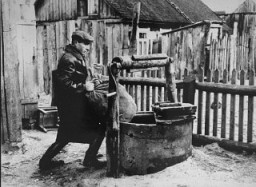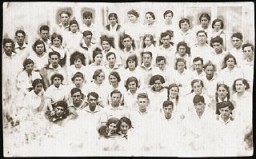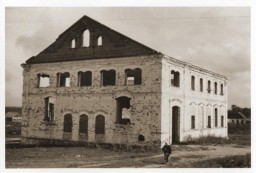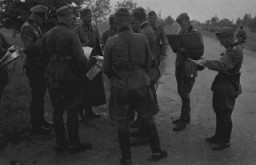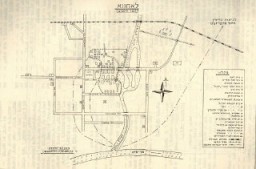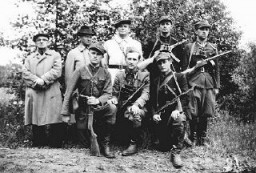Stanislawow (by Nechama Tec)
A Project of the Miles Lerman Center
This article excerpted from Nechama Tec, Resilience and Courage: Women, Men, and the Holocaust, New Haven: Yale University Press, 2003, pp. 336-339.
Little is known about the Jews of wartime Stanislawow, their lives, resistance, and deaths. In this brief and blurred history a chemical engineer named Anda Luft played an unusual role. If we examine this young woman's actions and those of the people around her we shall find some recurrent motifs.
The liquidation of the Stanislawow ghetto began on February 23, 1943. A few Jews with special qualifications were spared; the Germans intended to exploit them for a variety of purposes. Clearing up the deserted ghetto and sorting out the victims' possessions was probably their top priority, although a few factories continued to operate with Jewish laborers. Seven physicians were kept alive for an unspecified purpose. The Jews all knew that time was running out. They dealt with their circumstances in various ways. Six of the seven physicians collectively committed suicide. Other Jews went into previously prepared hiding places. Still others escaped into the surrounding forests. Among these escapees were Jewish laborers who had been employed outside the ghetto.
The very air breathed by the Jews seemed to warn that the Germans were preparing a final cleanup operation. Among those who escaped were Jewish employees of the Morgoshes leather factory. This group was led by Anda Luft; Dr. Kremizer, a dentist; and a young physician, Dr. Zimmer. During the escape the three commanders, guns in hand, had fired on the pursuing Germans. Defending their people as they ran, these leaders kept the road safe for seventy Jewish laborers. The entire group reached the forests close to the Bystrzca River in the Carpathian Mountains, where they formed a partisan unit. They had brought along a small reserve of arms and ammunition. Soon they met with a group of wounded Soviet officers and soldiers hidden in the mountains. Deciding that it would be better to pool their resources, the Jews took in the Soviet partisans. Through the Jewish physicians, the Russians regained their health. They next came upon a Soviet otriad (the Russian word for an official partisan detachment), Kolpak, in a nearby forest. They learned that one of these Russian partisans was a Jozef Lenobel, a Jewish ghetto escapee who had entered the Kolpak otriad pretending to be a Ukrainian named Franko Bilinski.
All along the Germans and their collaborators were vigorously pursuing the partisans. The Kolpak otriad incurred heavy losses as the Germans succeeded in killing most of the members. Lenobel eluded the enemy and joined the Jewish otriad. This detachment was well organized, and it was still run jointly by Anda Luft, Dr. Kremizer, and Dr. Zimmer.
Anda was tall and full of energy. A talented chemical engineer, she had been valued by the German directors of the leather factory, who promised her protection from the SS. But she had distrusted their assurances and preferred to escape with her co-workers. Those who knew Anda praised her intelligence and physical stamina. Although in an advanced stage of pregnancy at the time, she continued to be energetic; her fellow partisans called her “a blessing in the sea of enemies.”
The Jewish otriad reacted to the many pressures by splitting into smaller units, each of which had one weapon. These splinter groups turned into virtual watchdogs. Whenever a single German or a small number of them was spotted by any of these Jews, they would attack, killing the Germans and confiscating their weapons. In this manner, the Jews amassed more guns and ammunition. When they saw a larger group of enemy soldiers, the units would disperse as quickly as possible. Later on, they would reassemble at a previously agreed-upon site.
Food collection was undertaken by several men who were able to pass as Christians. Speaking flawless Ukrainian, these armed men had no trouble gathering provisions from the surrounding villages. At the temporary bases, a few women who belonged to the group were in charge of the cooking and other domestic duties. In my sources concerning the unit, these women are not mentioned by name, and I assume that Anda was not one of them.
In the summer of 1943, a large group of members of the Order Police (Ordnungspolizei) headed by the Gestapo, entered the forest to clear the area of Jewish partisans. The Jews, prepared, spread out as they had agreed earlier. The commandant of the Order Police, Captain Tausch, alone ventured deeper into the forest. He was caught by the Jewish partisans, who jumped down on him from the tree branches, an original way to launch an enemy assault.
Tausch was bound and marched to the partisan base, where he was brought before the commanders. After a brief trial, he was sentenced to death by hanging. The proud German fell to his knees, crying and pleading for mercy for himself, for his wife, and for his small children, who were awaiting his return. He was reminded of the way he had brutally chased his Jewish victims toward the cemetery, where they would be executed. The partisan judges informed him that considering the natures of his crimes their verdict was unusually mild. Captain Tausch was hanged on a huge branch of a pine tree.
Anticipating renewed attacks, the entire otriad moved quickly to another area. For a few months they managed to elude the enemy. Whenever possible, they would fight, inflicting loss of life and property. On July 11, 1943, Anda gave birth to a baby girl. Two physicians in the unit, Dr. Gerta Lieblein and Dr. Zimmer, assisted in the delivery. Immediately after the birth of the infant a partisan came running with the news he had heard on the radio: on this day the Americans had captured the Italian island of Pantelleria, a position the Germans had fiercely defended. To commemorate both victories of that day, the partisans gave the name Pantelleria to the newborn baby and to the detachment.
But the celebration was short-lived. Their lives were becoming more and more threatened. The initial cooperation that had existed between the Jewish partisans and the Koplak otriad ceased. A small remnant of the Soviet group moved away. The Jewish otriad had to rely on its own resources as it confronted the Germans, hostile villagers, and Ukrainian partisans of the Bandera group. The Bandera partisans (named after their nationalist hero) were well-armed, familiar with the area, and blessed with the full support of the local population.
In November 1943, the German police and army also began a series of forest raids. During one of these unexpected assaults several Jews fell, with axes in hand; among them were the Menis brothers, Regina Streit, and a Mrs. Demberg. The rest broke away. This attack was followed by another, initiated by the Bandera partisans in collaboration with local villagers. In the fierce, uneven battle that followed, only a few of the partisans survived. Most died fighting to the end.
Among these fighters was the commander Anda Luft. With Pantelleria, her infant daughter, strapped to her back, Anda continued to fire at the enemy up to the last moment. In the end, riddled with bullets, mother and child fell. Pantelleria the baby and Pantelleria the otriad each had a short life.1 This group's history underscores the consistent findings of this book: no matter how resilient and courageous the Jewish women and men were, most were overcome by the ruthless German power.
This article excerpted from Nechama Tec, Resilience and Courage: Women, Men, and the Holocaust, New Haven: Yale University Press, 2003, pp. 336-339.
Series: Resistance in the Smaller Ghettos of Eastern Europe
Critical Thinking Questions
- What pressures and motivations may have influenced Anda Luft's decisions and actions?
- What obstacles and limitations did Jews face when considering resistance? What pressures and motivations may have influenced their decisions and actions?
- Are these factors unique to this history or universal?
- How can societies, communities, and individuals reinforce and strengthen the willingness to stand up for others?
- Investigate the experiences of women who participated in or became leaders in resistance. Did they face additional pressures and obstacles?
Further Reading
Tec, Nechama. Resilience and Courage: Women, Men, and the Holocaust, New Haven: Yale University Press, 2003
Dr. A. Liebesman-Mikulski survived the war by living illegally on the Aryan side around his native Stanislawow. He describes his family's wartime experiences in a Yad Vashem document, 033/1093. After the war Dr. Liebesman-Mikulski collected information from the few remaining, scattered Jews who were a part of the Pantelleria otriad. These partisans were Jozef Lenobel, who at the time lived as a farmer near Netania, Dr. Kremizer, a dentist, who was living in South America, Max Hellman, living in West Germany; and Nachman Feuer, living in the United States. Dr. Libesman-Mikulsi also incorporated the results of his investigation into a portion of the Yad Vashem document also listed as 033/1093. My history of the Pantelleria group is based on these documents.
